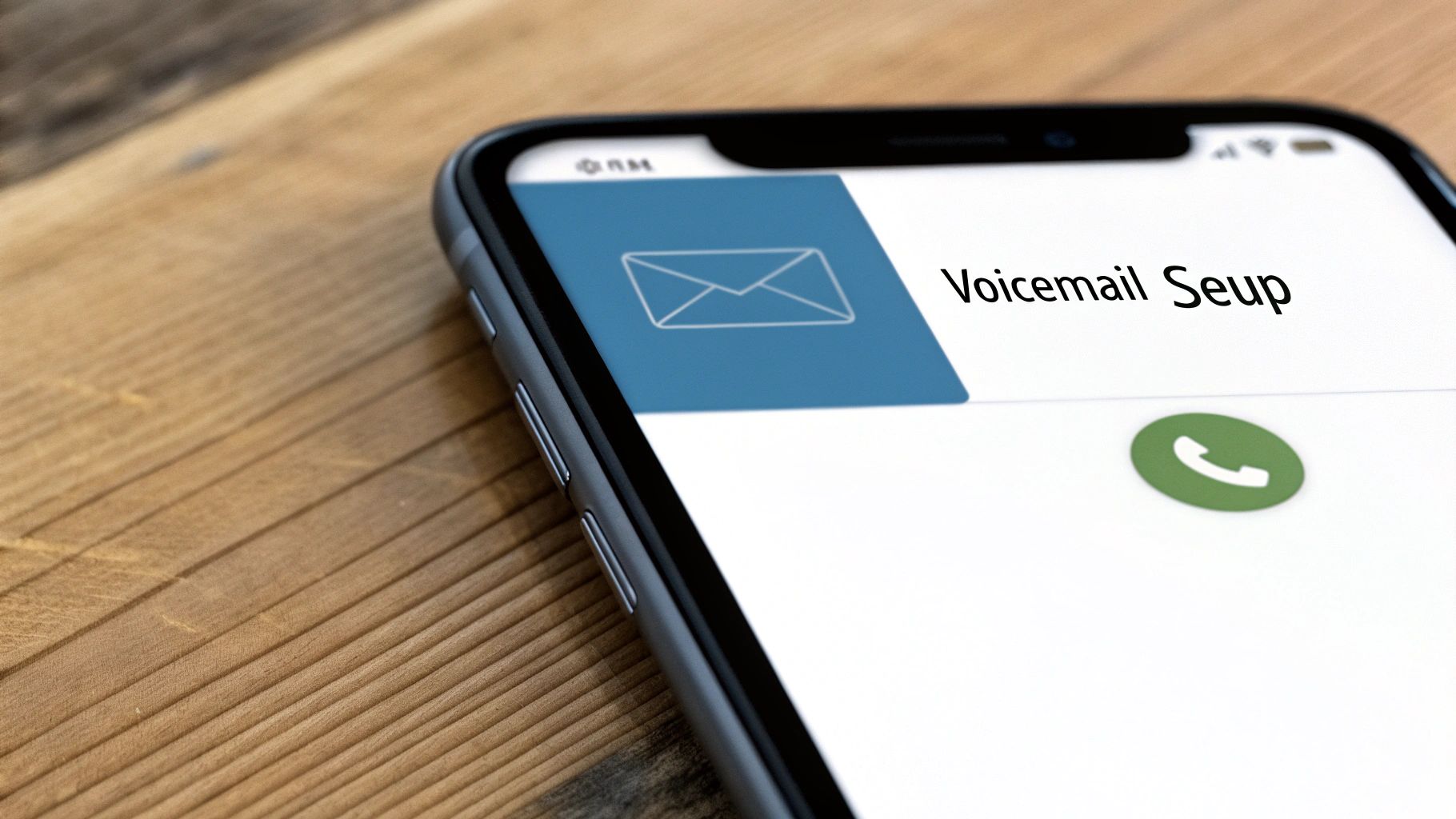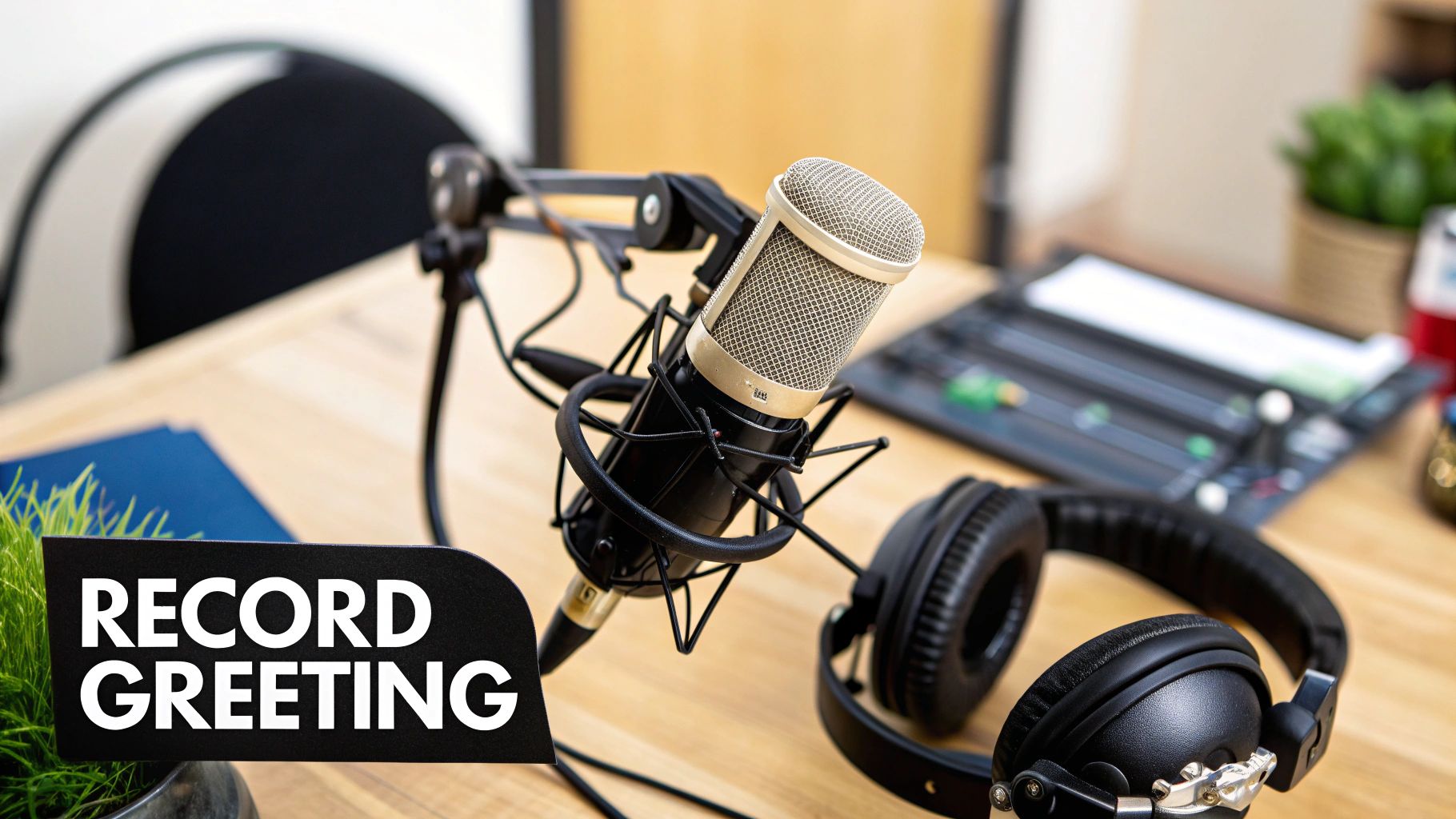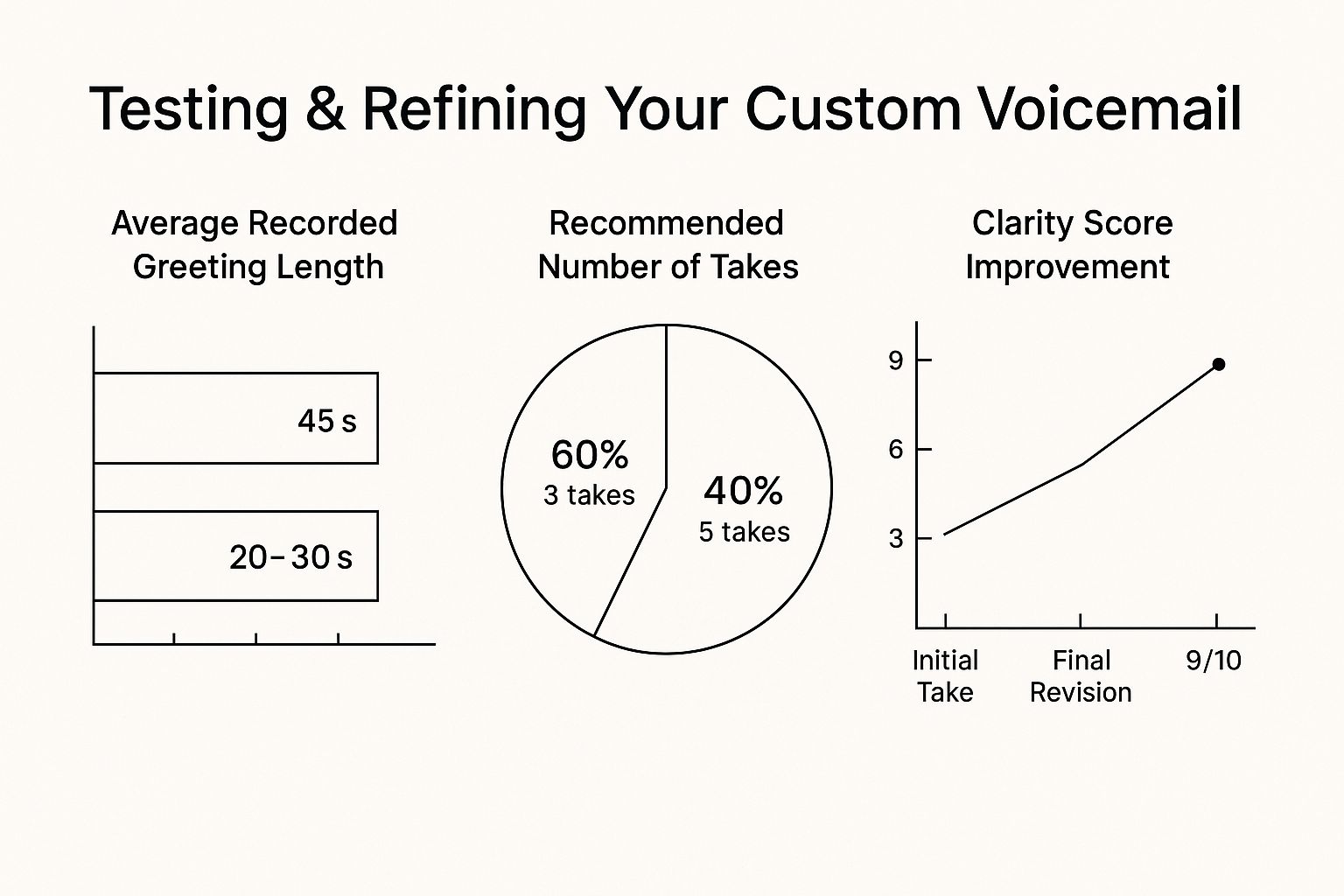That default, robotic voicemail greeting? It’s not just uninspired—it’s probably costing you business.
Every single time a call goes to a generic, system-generated message, you're missing a chance to make a real connection. Knowing how to make a custom voicemail isn't just a neat trick; it's how you turn a missed call into a genuine opportunity to build trust.

Think of your voicemail as the digital front door to your business. When a potential customer calls and you can't pick up, that greeting is your stand-in. A bland, robotic "You have reached 555-1234" is impersonal and, frankly, unhelpful. It tells the caller absolutely nothing about who you are or when they might hear back.
This lack of personality has a real-world impact. I've seen it time and again: many callers, especially from younger demographics, just hang up. They won't leave a message for a generic greeting, assuming it’s a dead line or that their message will just vanish into the ether. This is more than just an inconvenience—it's a direct path to lost revenue.
A custom voicemail greeting does more than just relay basic info; it projects professionalism and shows you care. When a caller hears a friendly, confident human voice, it immediately builds a sense of trust. It’s a small detail that signals you’ve put thought into every single touchpoint of your business, even the parts that run when you’re not there.
The psychological effect here is powerful. It reassures the caller that they’ve found the right place and that their inquiry is valued. In a world full of automated, cold interactions, a human touch—even a recorded one—makes a massive difference.
The goal isn't just to take a message; it's to start a relationship. A thoughtful greeting reassures callers, manages their expectations, and encourages them to take the next step, whether that's leaving a detailed message or visiting your website.
Modern tools have completely changed the game for business communications. A custom voicemail isn't just a simple recording anymore. With a platform like My AI Front Desk, your voicemail can become a proactive, strategic part of your business.
Just imagine a voicemail system that not only takes a message but also:
By learning how to create custom voicemail messages that are both personal and strategic, you transform a passive function into an active tool for lead capture and customer service. It’s a small change that can deliver a significant return by making sure every missed call still moves your business forward.

Before you even think about hitting that record button, the real magic happens with a pen and paper—or maybe just a blank document. A voicemail that actually works starts with a solid script, one that’s intentionally designed to get a specific result for your business. If you skip this step, you're likely to ramble, forget important information, or just sound plain unprofessional.
Think of your script as a roadmap. What do you really want the caller to do after they hear your message? The answer to that question shapes every single word you choose. Are you just trying to give out your after-hours info, or are you hoping to capture a hot new sales lead? Each of these goals requires a totally different game plan.
First things first: you need to decide on the one primary purpose of your voicemail greeting. If you try to cram too much into one short message, you'll just end up confusing people. The key is to focus on a single, clear objective.
Once you’ve nailed down your goal, writing the script becomes so much easier. A lead capture script for a local landscaping company, for example, should be warm and encouraging, asking callers for details about their project. On the other hand, an informational script for a retail store during the holidays should be quick and to the point, immediately stating the special hours.
A well-written script does more than just take a message; it actively guides the caller's next action. Think of it as a mini sales pitch or a customer service interaction, condensed into 20-30 seconds.
This is where so many businesses go wrong. They end up sounding like a corporate robot reading from a manual. Your script needs to be written in a way that sounds completely natural and conversational when you say it out loud. Use simple language, don't be afraid of contractions (like "we're" or "you've"), and keep the tone friendly and approachable.
A great tip is to read your script aloud a few times. Does it sound like something you'd actually say to a customer in person? If it feels stiff or overly formal, it's time for a rewrite. That personal touch is what separates a forgettable greeting from one that leaves a great impression and makes someone want to call you back. For some great examples of this in action, check out our guide on professional voicemail greetings examples, which has templates you can easily adapt.
The rise of AI-driven voicemail has added a whole new layer to this. In fact, industry analysts predict that by 2026, more than 80% of business voicemail systems will use some form of AI. These tools can help you perfect your script's tone and even personalize greetings for different types of callers.
Let’s see how this looks in practice across different types of businesses. Notice how each script has a very specific goal and a distinct tone to match.
Scenario 1: The Busy Freelance Designer
Scenario 2: The Local Plumbing Service (After-Hours)
As you can see, a well-thought-out script is a powerful tool. It can effectively manage your incoming calls, provide genuine value to your callers, and help you maintain a professional image—even when you’re not there to pick up the phone.

Alright, you've got a killer script ready to go. Now for the fun part: turning those words into the actual voice of your business. This is where platforms like My AI Front Desk really shine, handling the techy stuff so you can focus on the final sound.
The image above gives you a peek at how simple the interface is. You're presented with a few different ways to create your greeting, which means you can pick the one that feels right for your brand and your own comfort level. No audio engineering degree required—just a decision on which voice best represents you.
The first big choice is deciding how you want to sound. You've generally got three main paths to go down, each with its own vibe. This decision really sets the tone for the caller's experience, so think about the first impression you want to make.
Here's the key takeaway: Technology has leveled the playing field for professional communication. You no longer need a fancy recording studio to create a top-notch voicemail greeting that builds instant trust with your callers.
If you decide to use your own voice, a few simple tricks can make a massive difference in your audio quality. You don't need a pro-level microphone; a quiet spot and your smartphone can work wonders.
For clean, crisp audio, find a small room with soft surfaces—think carpets, curtains, or even a closet full of clothes. These materials are great at soaking up echo and will give you a much clearer sound. Hold your phone about six inches from your mouth and speak clearly at a natural, unhurried pace. It always helps to do a few practice runs to get comfortable with the script.
Taking a few minutes to get this right is crucial for making your business sound as professional as it is. If you're curious about how far this tech can go, it's pretty interesting to see how you can create sounds with AI, which can add unique intros or background effects to your greetings.
When you're using text-to-speech, the goal is to avoid that robotic sound. The secret is all in how you write the script for the AI.
Use conversational language, just like you're talking to a real person. Add pauses with commas or ellipses (...) and mix up your sentence lengths. Instead of writing, "Please leave a message after the tone," try something more natural like, "I'd love to hear from you, so please leave your details after the beep."
Platforms like My AI Front Desk use advanced models for their AI-powered message taking to ensure the final delivery is smooth, engaging, and genuinely human-like.
The market for voice-activated apps shows just how much people value this. It was valued at $5.97 billion in 2024 and is expected to rocket to $87.5 billion by 2034. This growth is all about AI advancements making these interactions feel more personal. A well-crafted AI voicemail is a perfect example of how you can use this trend to keep your business ahead of the curve.
A great voicemail script is a solid start, but let's be honest—it's just the beginning. The real magic happens when you start treating your voicemail system as a strategic tool for actively growing your business. With the right features, your simple answering service can become an automated sales and service channel that works for you around the clock.
This is where you graduate from just knowing how to make a custom voicemail to using it to its fullest potential. Think about it: you can set up different greetings based on the time of day or even who’s calling. A contractor, for example, could have an after-hours greeting that automatically funnels urgent repair calls to an on-call technician while neatly capturing new estimate requests for the morning team.
An intelligent voicemail system doesn't just record messages; it gets to work on them. Imagine a local contractor whose system automatically transcribes messages from new callers asking for an estimate. That text, along with the caller's info, can be instantly pushed into their CRM or project management software as a brand-new lead. No manual entry needed.
This kind of automation is a total game-changer. It cuts out tedious data entry, dramatically reduces the chance of leads falling through the cracks, and guarantees a much faster response time. For an e-commerce store, a similar setup could answer common questions about order status or return policies directly within the voicemail, freeing up your team for more complex issues.
The goal is to make your voicemail an integral part of your customer communication strategy. It shouldn't just capture information but also kick off the next step in the customer journey, whether that's scheduling an appointment or resolving a query.
The image below breaks down some key metrics to keep in mind when you're testing and tweaking your greeting. It really highlights how crucial length, practice, and clarity are for making a real impact.

The data makes it clear: shorter, well-rehearsed greetings deliver a much clearer message, making them far more effective for the caller.
The rise of VoIP has made these kinds of advanced systems accessible to businesses of all sizes. To really get the most out of your voicemail, it helps to understand the foundation of modern communication, like a smooth VoIP phone system installation. This is the technology that powers the features that drive real business growth.
The global market for VoIP services was valued at USD 151.21 billion in 2024 and is still climbing. Small and mid-sized businesses are a huge part of this trend, often using custom voicemail as part of their cloud-based setups, a sector predicted to grow by 26% between 2024 and 2029.
Of course, these systems do more than just record audio. With a platform like My AI Front Desk, you unlock powerful tools like voicemail transcription. This feature is a lifesaver—it turns all those audio files into searchable text, so you can find customer details or review conversations without listening to hours of messages. You can learn more about how AI voicemail transcription benefits small businesses in our detailed guide.
When you start using tools like these, your voicemail transforms from a simple message inbox into a rich source of business intelligence.
To see just how far voicemail technology has come, it's helpful to compare a standard, out-of-the-box system with an AI-powered one. The difference is night and day.
As you can see, an AI-powered system doesn't just take messages—it acts on them, turning your voicemail from a passive mailbox into an active, intelligent part of your business operations.
Of course. Here is the rewritten section, crafted to sound like a human expert and match the provided examples:
Setting up a custom voicemail is a fantastic first step, but it's surprisingly easy to fall into a few common traps. These little slip-ups can make your business sound less than polished, undoing all your hard work. The good news is that once you know what to look for, they’re simple to fix.
One of the most frequent culprits is just plain bad audio quality. A greeting recorded with barking dogs, office chatter, or passing traffic in the background instantly screams amateur hour. It’s distracting and hints that you might not be too concerned with the details.
Another classic blunder is the rambling, unscripted message. It’s so easy to go off on a tangent or fill the space with "ums" and "ahs" when you're just winging it. This not only sounds unprofessional but can leave your callers confused about what you actually want them to do. A tight, clear message respects their time and gets right to the point.
Forgetting to update your voicemail is a huge oversight. Nothing says "nobody's home" quite like a cheerful greeting announcing holiday hours from last December. A message promoting an offer that ended months ago is even worse than a generic recording because it tells customers no one is paying attention.
A voicemail greeting is a direct reflection of your brand's current state. If the information is old, callers will assume your business operations are just as disorganized.
Then there's the issue of brand consistency. If your website is buttoned-up and professional, but your voicemail is super casual and jokey, it creates a jarring experience for the customer. Your voicemail needs to feel like it’s part of the same family as your website, emails, and social media.
This is where a system like My AI Front Desk really shines. It helps you sidestep these problems entirely.
Finally, don't give your callers analysis paralysis. Asking them to leave a message, visit your website, send an email, and follow you on three social media platforms is just too much. A confused caller is far more likely to just hang up than to complete any of your requests.
Pick one primary action you want the caller to take and make it the star of the show. If the goal is to get them to your website, make that the final, unmistakable instruction. By keeping your call to action singular and simple, you dramatically boost the odds they'll actually do it—turning that missed call into a genuine opportunity.
Even with a solid plan, jumping into a new system always brings up a few last-minute questions. Knowing how to set up a custom voicemail is one thing, but getting the little details right is what makes for a truly smooth launch. Let's walk through some of the most common questions we hear from business owners just like you.
One of the first things people ask is about authenticity. They worry that using an AI receptionist means their business will sound cold or robotic.
Of course! This is a huge concern for many, but a platform like My AI Front Desk is designed specifically for personalization. You aren't locked into a single option; you have several ways to create your greeting so it perfectly matches your brand's voice.
This kind of flexibility means you never have to choose between a personal touch and powerful features.
The answer really depends on the rhythm of your business. As a general rule, it’s smart to check your main greeting at least once a quarter. This ensures basic info, like your business hours, is still spot-on.
But the real magic happens when you make timely, dynamic updates. You’ll want to create fresh greetings for specific situations, such as:
An AI system makes this incredibly simple. Instead of the hassle of re-recording audio every single time, you can just type out a new script and generate a polished, professional greeting in seconds.
Your voicemail greeting should be a living part of your business communications, not a "set it and forget it" task. Keeping it current shows callers you're attentive and on top of your game.
Yes, absolutely. Seamless integration is a core part of how modern AI receptionist services are designed. These systems are built to work perfectly with your existing business phone number, so there’s no need to disrupt your current setup or confuse your customers.
The setup usually involves a simple call forwarding configuration. You just tell your existing phone line to forward calls to the AI service whenever your line is busy or after a certain number of rings. For a closer look at how this works, check out our guide on how to allow voicemails in My AI Front Desk.
This way, you keep the phone number your customers already know and trust while unlocking all the advanced capabilities of an intelligent voicemail system.
Ready to transform your voicemail from a simple answering machine into a powerful business tool? With My AI Front Desk, you can create professional, AI-powered greetings in minutes, capture more leads, and provide a world-class experience for every caller. Start your free trial today and discover how an intelligent front desk can drive real growth for your business.
Start your free trial for My AI Front Desk today, it takes minutes to setup!








